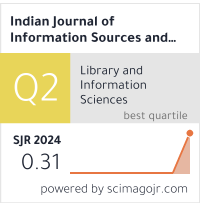Ranking of Universities: A Study for Last Four Years of Top 25 Indian Universities
DOI:
https://doi.org/10.51983/ijiss-2021.11.2.2959Keywords:
National Institutional Ranking Framework, NIRF, Ranking Parameters, Top 25 Universities-Ranking, Performance of Ranking Parameters , Sub-ParametersAbstract
National Institutional Ranking Framework (NIRF) is a system adopted by the Ministry of Education, Govt. of India (formerly referred to as Ministry of Human Resource Development (MHRD)), so as to rank all institutions. However, all things considered the NIRF results from a separate perspective this complete exercise has laid the very foundations of data-driven education and e-governance. The NIRF Ranking System is predicated on five parameters i) TLR, ii) RP, iii) GO, iv) OI and v) PR a stress on adopting an ERP framework to make sure a gentle real-time flow of the multifaceted datasets from institutions could have helped the cause during a much remarkable manner. This study is meant to analyzing the contributions made by the highest 25 Universities as ranked by NIRF within the aspects of various sub-parameters score under Research and Professional Practices key parameter. This article analyses data on three years (2019, 2020 & 2021 of India Rankings to assess its impact on performance of Teaching, Learning and Resources (TLR), Research and Professional Practice (RP), Outreach and Inclusivity (OI), Graduation Outcomes (GO), Peer Perception (PR) parameters and their sub-parameters of top 25 universities are discussed. The analysis of knowledge on four years of India Rankings, i.e. 2018 to 2021 on various performance sub-parameters of top 25 universities provides a stimulating rank and score reveal that participating institutions are improving every year and getting improved scores. The HEIs are also making tremendous efforts to enhance their performance on various parameters or sub-parameters identified by the NIRF for the ranking of universities.
References
NIRF. (2020). Retrieved from https://www.nirfindia.org/nirfpdfcdn/2020/graph/ University/IR-O-U-0220.jpg.
NIRF. (2019). Retrieved from https://www.nirfindia.org/nirfpdfcdn/2019/graph/ University/1.jpg.
NIRF. (2018). Retrieved from https://www.nirfindia.org/nirfpdfcdn/2018/graph/ UNIVERSITY/IR-1-O-O-U-0220.jpeg.
Nassa, A., Arora, J., Singh, P., Joorel, J. P., Trivedi, K., Solanki, H., & Kumar, A. (2021). Five Years of India Rankings NIRF and its Impact on Performance Parameters of Engineering Institutions in India Pt 2 Research and Professional Practices. DESIDOC Journal of Library & Information Technology, 41(02), 116-129. Retrieved from https://doi.org/10.14429/djlit.41.02.16674.
Vijayakumar, M., Satish Kumar, H. T., & Trivedi, Mayank. (2018). A Study on Research Trends in Central Universities of India. 5th International Symposium on Emerging Trends and Technologies in Libraries and Information Services (ETTLIS), 297-304. https://doi.org/10.1109/ETTLIS.2018.8488339.
Mukherjee, Bhaskar (2019). Ranking Indian universities through research and professional practices of National Institutional Ranking Framework (NIRF): A case study of selected central universities in India. Journal of Indian Library Association, 52(4). Retrieved from https://www.ilaindia.net/jila/index.php/jila/article/view/87.
Reddy, K. S. (2015). Higher Education, High-impact Research and University Rankings: A Case of India. MPRA, 63658, 1–39. Retrieved from https://mpra.ub.unimuenchen.de/63658.
Hazelkorn, E. (2015). Rankings and the reshaping of higher education: The battle for world-class excellence. London: Palgrave Macmillan.
Sivakumaran, K. S. (2017). Contributions of Publications of Indian Institute of Management in Ranking Institutions in National Institutional Ranking Framework: A Study. International Research: Journal of Library & Information Science, 7(2), 314-322.
Vernon, M. M., Balas, E. A., & Momani, S. (2018). Are university rankings useful to improve research? A systematic review. PLOS ONE, 13(3), e0193762. Retrieved from https://doi.org/10.1371/ journal.pone.0193762.
Verma, Manoj Kumar & Brahma, Krishna (2017). Ranking of National Institutes of Technology (NITs) of northeast vicinity of India on the idea of net effect aspect. COLLET Journal of Scientometrics and Information Management, 11(2), 235-248. DOI: 10.1080/09737766.2017.1292667.
NIRF. (2018). Retrieved from https://www.nirfindia.org/2018/University Ranking. html.
NIRF. (2019). Retrieved from https://www.nirfindia.org/2019/University Ranking. html.
NIRF. (2020). Retrieved from https://www.nirfindia.org/2020/University Ranking. html.
Downloads
Published
How to Cite
Issue
Section
License
Copyright (c) 2021 The Research Publication

This work is licensed under a Creative Commons Attribution-NonCommercial-NoDerivatives 4.0 International License.









